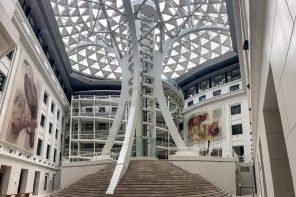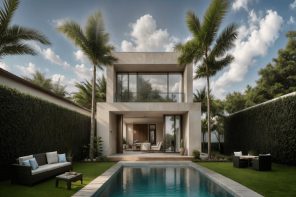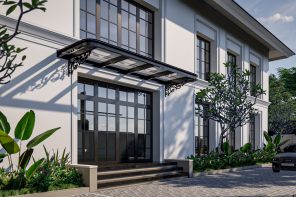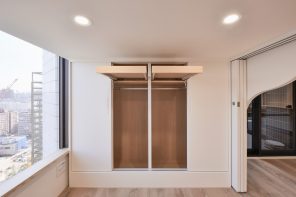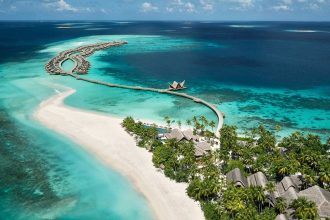In recent years, hotels and resorts across Asia have embraced a trend that brings the outdoors in, known as “biophilic” or nature-inspired design. This architectural approach goes beyond just incorporating greenery; it seeks to create spaces that foster a connection with the natural world, enhancing guest well-being and promoting a sense of harmony with the environment. Asia’s top architects and designers are pioneering this trend by crafting immersive environments that bridge modern luxury with the tranquility and vibrancy of nature.
Biophilic design in hospitality combines natural materials, open spaces, and breathtaking landscapes, offering an eco-conscious alternative to traditional architecture that appeals to travelers seeking a deeper connection with their surroundings. Although nature-inspired designs can sometimes be challenging due to environmental regulations or maintenance demands, the advantages of improved mental wellness, environmental sustainability, and a unique, serene ambiance make it a thriving trend.
This movement toward nature-inspired architecture is especially pronounced in Southeast Asia, where lush rainforests, dramatic coastlines, and rich biodiversity provide an ideal setting for innovative design. Here are some standout hotels and resorts leading the biophilic charge, offering travelers memorable experiences that blend luxury with the allure of nature.
1. Hyatt Centric
The Hyatt Centric in Kota Kinabalu, Malaysia, is a stunning example of nature-inspired design by world-renowned architect Kengo Kuma. Conceptualized to resemble a giant tree, the hotel’s architecture embraces the lush, tropical landscapes of Sabah, a region known for its natural beauty and biodiversity.
The Hyatt Centric structure uses wood and natural materials throughout its interiors and exteriors, embodying Kuma’s signature approach of blending buildings with their surroundings. Floor-to-ceiling windows and open-air corridors invite ample natural light and ventilation, reducing energy usage while providing guests with immersive views of the outdoors. This tree-like structure stands as a symbol of unity with the environment, allowing guests to experience a design that is both innovative and in harmony with nature.
2. The Datai
Nestled in the heart of an ancient rainforest, The Datai in Langkawi, Malaysia, is an iconic resort known for its seamless integration with the surrounding wilderness. Designed by Kerry Hill, The Datai’s architecture respects and enhances the existing ecosystem, with buildings constructed to blend in with their environment, using native materials and traditional techniques.
The rainforest becomes a central part of the guest experience, from pathways that meander through lush foliage to villas that appear almost hidden within the dense greenery. With the Andaman Sea visible in the distance, The Datai invites guests to connect with the beauty and tranquility of Langkawi’s natural environment, establishing itself as a pioneer in sustainable, biophilic resort design.
3. Buahan
Located in Bali, Indonesia, Buahan offers a unique “no walls, no doors” concept that fully immerses guests in the surrounding tropical forest. Designed by Rumah Intahan Architects, this resort redefines privacy and intimacy by removing physical barriers between indoor and outdoor spaces, allowing guests to feel at one with nature.
The resort’s villas are open-air spaces, with strategic positioning that provides stunning views of Bali’s lush landscapes while maintaining a sense of seclusion. The integration of natural materials like bamboo, local wood, and stone enhances the resort’s earthy ambiance, creating a harmonious blend with the surrounding forest. Buahan is a bold example of how nature-inspired design can push boundaries while creating a sense of sanctuary for guests, blending luxury with the wild beauty of Bali.
Related article: Top 3 Islands in Southeast Asia with the Best Selection of Luxury Holiday Villas
Other Nature-Inspired Hotels and Resorts in Asia
Apart from these pioneers, other hotels and resorts in Asia have adopted the nature-inspired approach in their own unique ways, each showcasing the versatility and appeal of biophilic design.
1. Pan Pacific Orchard
Located in the heart of Singapore, Pan Pacific Orchard is a vertical oasis that incorporates greenery throughout its many levels. With four distinct “forest” themes, this property prioritizes biodiversity by creating elevated green spaces that offer a break from the city’s bustling energy.
Open-air corridors and garden terraces invite guests to enjoy natural ventilation and verdant surroundings while embracing Singapore’s tropical climate. The design not only enhances visual appeal but also offers energy-saving benefits, making it an exemplary model of urban biophilic architecture.
Related article: Pan Pacific Service Suites Orchard Sets a New Standard for Luxury Long-Term Accommodations in Singapore
2. Kai Yufuin
In Kyushu – just 12 hours away from Tokyo, Japan, the Kai Yufuin resort draws inspiration from the surrounding rural landscape, creating a serene escape that celebrates Japanese traditions and nature. The design utilizes natural materials like cedar wood and volcanic stones, common in Japanese architecture, and places an emphasis on connecting guests with the nearby Mount Yufu’s scenic beauty.
Guests can soak in traditional onsen hot springs while taking in breathtaking views, a nod to the biophilic principles of relaxation and harmony with nature that Japanese design is known for.
Related article: 10 Best Luxury Hotels and Resorts in Tokyo
3. Four Seasons Hotel
Located along the Chao Phraya River in Bangkok, the Four Seasons Hotel brings biophilic principles to urban Bangkok. Its design incorporates lush green spaces, water features, and open terraces that echo the vibrancy of the river. The hotel’s interior décor includes natural textures and materials, creating an organic feel that is both refreshing and luxurious. Guests can enjoy views of the river and nearby gardens, bridging the gap between nature and the bustling cityscape in a way that few urban hotels can achieve.
The Evolution and Impact of Nature-Inspired Design
As the biophilic trend continues to evolve, it drives hotels and resorts toward increasingly sustainable practices, from sourcing local materials to implementing energy-efficient solutions. In Southeast Asia, destinations like Bali, Indonesia, and historic landmarks such as Angkor Wat inspire designers to craft spaces that honor cultural and natural heritage while catering to the modern traveler’s desire for eco-conscious luxury.
For travelers, nature-inspired design in hotels and resorts offers more than just visual appeal—it provides a means to decompress, reconnect, and rejuvenate. The hospitality industry benefits as well, as these designs set new standards for responsible tourism and elevate the guest experience, meeting the growing demand for sustainable, unique, and immersive stays.
Exploring a biophilic resort in Asia is more than just a getaway; it’s a chance to experience the region’s rich biodiversity and cultural heritage in a way that leaves a positive impact. For travelers planning their next trip, exploring these new nature-inspired resorts promises an unforgettable experience that harmonizes comfort, luxury, and sustainability. Check out any of these biophilic properties across Asia to enjoy a true retreat back to nature, elevated by thoughtful, eco-conscious design.
–
Featured Image by Tripadvisor





